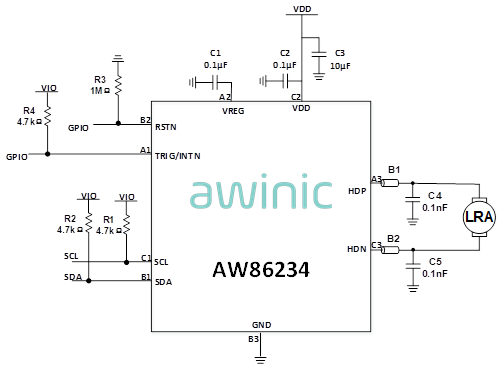| Voltage Type |
Vbat |
| Vout (Max) (V) |
5.5 |
| SRAM (kB) |
3 |
| Istandby (μA) |
2 |
| IO Level (V) |
1.2
1.8
3.3 |
| AAE |
YES |
| Input Signal |
IIC
1TRIG |
| LRA Calibration |
LCC3.0 |
| Temperature |
-40℃~85℃ |
| TikTap |
YES |
| Package (mm) |
FCQFN 1.37X1.37-9L(0.4) |
Features
?1MHz I2C Bus
?Integrated 3K Memory
?12k/24k/48k input wave sampling rate
?F0 detect and tracking
?Advance autobrake engine integrated
?Playback mode:
?Real time playback
?Auto dynamic sine playback
?Memory playback
?Trigger playback
?Cont playback
?Resistance-Based LRA Diagnostics
?Drive signal monitor for LRA protect
?Drive Compensation Over Battery Discharge
?Fast Start Up Time: 0.4ms
?Reused interrupt output pin
?Support automatically switch to standby mode
?Standby current: 2μA
?Shutdown current:<1μA
?Supply voltage range 2.7 to 5.5V
?Short-Circuit Protection, Over-Temperature Protection, Under-Voltage Protection
AW8623X is a low cost H-bridge, single chip LRA haptic driver, with F0 detecting and tracking based on BEMF, supporting real time playback, memory playback, Cont playback, and hardware pin trigged playback with fast start up time. All these make the AW8623X an ideal candidate for haptic driver.
AW8623X integrates a 3KByte SRAM for user-defined waveforms to achieve a variety of vibration experiences, supporting 3 sampling rate(12k/24k/48k) of waveforms loaded in SRAM, supporting output waveform sampling rate up-sampling to 48k.
AW8623X integrates an autobrake engine to suppress the aftershocks to zero for different drive waveforms (short or long) on different LRA motors.
AW8623X supports LRA fault diagnostic based on resistance measurement and protections of short-circuit, over-temperature and under-voltage.
AW8623X features configurable automatically switch to standby mode after haptic waveform playback finished. This can less quiescent power consumption. The RSTN pin provides further power saving by fully shut down the whole device. Reused interrupt output pin can detect real time FIFO status and the error status of the chip.
AW8623X features general settings are communicated via an I2C-bus interface.

